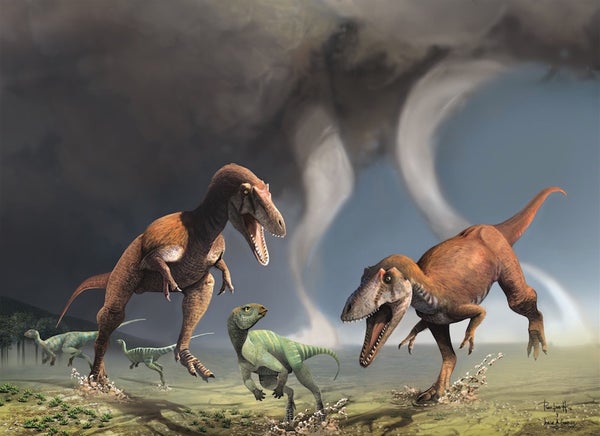Tyrannosaurus rex wasn't the only meat-eating menace with teeny-tiny arms.
Like its distant relative, T. rex, a newly identified dinosaur, named Gualicho shinyae, sported small arms and hands with two clawed fingers.
"We're slowly getting more information on this sort of pattern of limb reduction, and getting at this question of why tyrannosaurs and some other theropods shortened their forelimbs," said study corresponding author Peter Makovicky, curator of dinosaurs at the Field Museum in Chicago. [See Images of the Tiny-Armed Gualicho shinyae]
On supporting science journalism
If you're enjoying this article, consider supporting our award-winning journalism by subscribing. By purchasing a subscription you are helping to ensure the future of impactful stories about the discoveries and ideas shaping our world today.
G. shinyae belonged to a group called the allosaurs and lived about 90 million years ago, during the Cretaceous period. That's a good 23 million years before T. rex entered the scene between 67 million and 65 million years ago.
Because they are only distantly related (both are considered theropods, which are bipedal and mostly carnivorous dinosaurs), the two species likely developed their tiny arms and two-digit hands independently due to similar evolutionary pressures — a process called convergent evolution, the researchers said.
Bony discovery
Study lead author Sebastia?n Apestegui?a, a paleontologist with the Natural History Foundation (AZARA) in Buenos Aires, Argentina, and a team of researchers discovered the dinosaur along the northern edge of a large reservoir in Patagonia, Argentina, in 2007. (In fact, five other predatory dinosaurs have also been found in that area, called the Huincul Formation.)
"Unfortunately, it's one of those specimens that was discovered probably 50 years too late," Makovicky told Live Science. "We have the hind limbs and the forelimbs, we have the section of the back and the tail, a little bit of the hips." But they couldn't locate the skull and much of the vertebral column, likely because of erosion.
However, based on what they found, as well as the anatomy of other allosaurus dinosaurs, they estimate that at its hipsG. shinyae was about 6 feet (1.8 meters) tall, and that it measured about 25 feet (7.6 m) long and weighed about 1 metric ton (1.1 tons), Makovicky said.
"It's not a giant animal by dinosaur standards, but not small, either, so [it's] a midsize predator," he said.
G. shinyae is also a bizarre mosaic of different dinosaurs. It looks a bit like Carcharodontosaurus, another carnivorous theropod, as well as Deltadromeus (delta runner), a carnivorous dinosaur with slender arms found in Africa, which is possibly a close relative, the researchers said. [Photos: Dinosaur's Battle Wounds Preserved in Tyrannosaur Skull]
Divine inspiration
Researchers named the dinosaur Gualicho shinyae after two women: The genus honors Gualichu, a goddess of animals who was revered by the Tehuelche people of Patagonia. When Europeans brought Christianity to the area, the newcomers reinterpreted Gualichu as a demonic entity, the researchers wrote in the study.
The paleontologists joked that Gualichu had put a curse on them during their fieldwork, after their truck flipped over (no one was seriously hurt), Makovicky said. The species name honors Akiko Shinya, who discovered the specimen.
The newfound dinosaur is an exciting find, said Thomas Carr, an associate professor of biology at Carthage College in Wisconsin, who was not involved in the study.
"It really provides a sharper focus on the whole phenomenon of forelimb reduction and finger loss in theropods," Carr said. "It clearly occurs across many different lineages for different reasons and in different ways."
It also shows that "tyrannosaurs' [arms] really aren't unusual," Carr said. "It's not just a one-off."
The new study was published online today (July 13) in the journal PLOS ONE.
Copyright 2016 LiveScience, a Purch company. All rights reserved. This material may not be published, broadcast, rewritten or redistributed.
